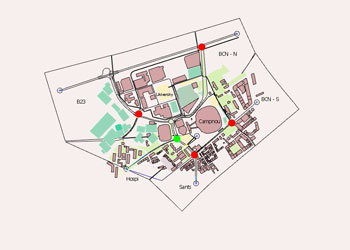
How to create new Object Attributes for easier editing
July 2019: Dimitris Triantafyllos shares a pro tip video for keeping track of revised nodes in your project to speed up the editing process.
February 2017
By Sara Pardo
Non-graphical objects in Aimsun are listed in the Project Window by object type. By default, objects are listed in alphabetical order by name, however, in Aimsun you can customize the order of your objects for clearer and more semantic organisation. Here’s an example:
Imagine that you have dozens of subpaths, each one identified by a name representing the main streets on their route. It might be useful to you to list them by, say, direction, e.g., Northbound, Westbound etc.
As that attribute does not exist by default, you can take advantage of the Aimsun extensible model that allows you to define new attributes for any type of object. Those new attributes can be displayed afterwards via View Modes and View Styles in 2D Views; furthermore, they will allow you to customize the order in which objects are listed in the Project Window, as in the example below:
To do this, first add a new attribute to the Subpath class using the Types window:
Click to enlarge. Figure 1 – Add a new attribute to the Subpath class using the Types window
Click to enlarge. Figure 2 – Add a new attribute to the Subpath class using the Types window
Once the attribute is created, edit the value for each subpath using the Table View or the Subpath editor.
Click to enlarge. Figure 3 – Edit the value for each subpath using the Table View or the Subpath editor
Once the attribute values are ready for all subpaths, you can customize the way they will be grouped in the Project Window by editing the Subpaths folder properties.
Specify that you want to group objects by attribute and select the desired attribute (in this case, Subpath Direction) as the Primary Attribute.
Click to enlarge. Figure 4 – Specify that you want to group objects by attribute and select the desired attribute (in this case, Subpath Direction) as the Primary Attribute
In the Subpaths folder, Aimsun creates as many subfolders as different values are defined for that attribute, allowing you to group your objects as desired.
Click to enlarge. Figure 5 – In the Subpaths folder, Aimsun creates as many subfolders as different values are defined for that attribute
Just recreate these steps to order any type of object in your Project Window.

July 2019: Dimitris Triantafyllos shares a pro tip video for keeping track of revised nodes in your project to speed up the editing process.

June 2016: Dimitris Triantafyllos explains how the Aimsun Revisions tool allows a modelling team to work within a single file, for faster and less error-prone collaboration.
SHARE
Aimsun Next 24
Aimsun (2024). Aimsun Next 24 User’s Manual, Aimsun Next Version 24.0.0, Barcelona, Spain. Accessed on: April. 16, 2024. [Online].
Available: https://docs.aimsun.com/next/24.0.0/
Aimsun Next 24
@manual {AimsunManual,
title = {Aimsun Next 24 User’s Manual},
author = {Aimsun},
edition = {Aimsun Next 24.0.0},
address = {Barcelona, Spain},
year = {2024. [Online]},
month = {Accessed on: Month, Day, Year},
url = {https://docs.aimsun.com/next/24.0.0},
}
Aimsun Next 24
TY – COMP
T1 – Aimsun Next 24 User’s Manual
A1 – Aimsun
ET – Aimsun Next Version 24.0.0
Y1 – 2024
Y2 – Accessed on: Month, Day, Year
CY – Barcelona, Spain
PB – Aimsun
UR – [In software]. Available:
https://docs.aimsun.com/next/24.0.0/